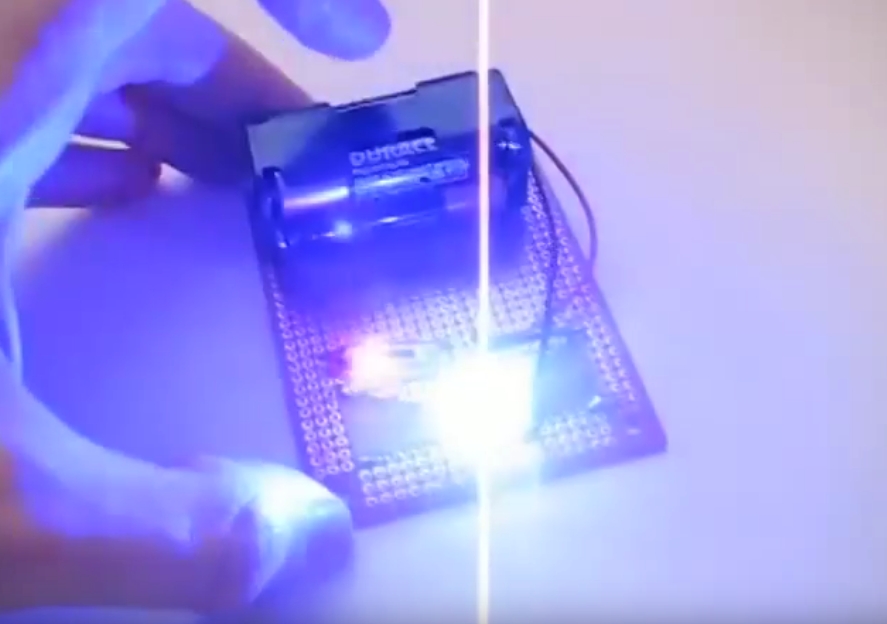The last flashlight is tired or Will the flicker save Belarus (upd. Spinner?)
Each svyadomy (well, the other too)Belarusian knows what a flicker is. Regardless of social status, age, gender, etc. Naturally, even jokingly repeatedly beat this topic. It would seem that with such an approach to business, mortality on night roads in Belarus should have swiftly rushed to 0, and then generally remained only in memories. But life judged differently, more and more often in reports on road accidents it was indicated that "the downed pedestrian was with flickers." And the point here is that the retroreflective elements with aliexpress sold in each stall are not considered mainly as an element of equipment that can save a life, but as protection against a traffic police fine. Those. "Just to hang." It is not surprising that low-quality retroreflective tapes cease retroreflecting quite quickly (and often do not immediately show excellent performance). Having active walking parents in a small town, I periodically thought about their safety and came to the conclusion that, instead of focusing on the quality of retroreflective elements, you just need to provide your mom and folder with active long-playing light beacons. The topic will be useful not only for night pedestrians / cyclists, but also for pet owners who are prone to night vagrancy (+ “where does the spinner really mean?”). My reasoning on this subject is to look under the cut. prone to nighttime vagrancy (+ "where does the spinner at all?"). My reasoning on this subject is to look under the cut. prone to nighttime vagrancy (+ "where does the spinner at all?"). My reasoning on this subject is to look under the cut.
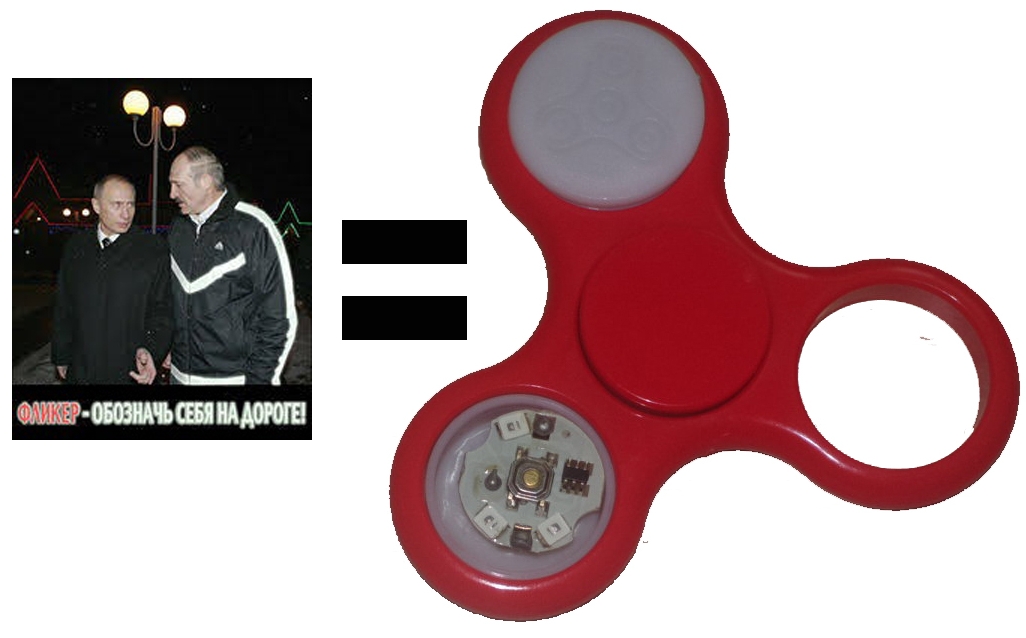
This whole story began with the fact that in early 2007 the GAI of Belarus announced the implementation of the Minus 100 campaign, whose goal was to "reduce the number of deaths from road traffic crashes by at least 100 people compared to 2006." At the same time, personal mounted retroreflective elements - “flickers” were massively thrown into the sale. The state media acted as informational support, urging their propaganda materials to stimulate unprecedented demand for these crafts. The progressive part of the population took this, generally good idea, with hostility, the fact of the presence of a flicker automatically equated the wearer with the lowest layers of the population. Perhaps this is due to the fact that initially these "state retroreflectors" were from the same sphere, as fire detectors / validators in public transport, etc. + disgusting, artsy design / drawing and all that’s all (after 5-7 years, by the way, neutral models or just _ne_ cutting eyes) began to appear). The second factor was the fact that despite the fact that the flicker was required to be worn only on dark, unlit sections of the road, in the traffic police provinces they caught and fined people without flickers even in an open field (I exaggerate, but not much). It is worth noting that the flickers still did their good deed. in the provinces of the traffic police caught and fined people without flickers even in the open field (I exaggerate, but not much). It is worth noting that the flickers still did their good deed. in the provinces of the traffic police caught and fined people without flickers even in the open field (I exaggerate, but not much). It is worth noting that the flickers still did their good deed.replenishing the treasury with fines , reducing mortality on the roads. As a result of the Minus 100 program, in 2007 almost 200 people died on the roads less than in 2006 ( of.prof ). After completing the Minus 100 program, we forgot about flickers for a while, so that later in 2010 we could start a new round ... In general, this is an important topic for Belarusian society.
Despite the negative attitude to the flicker-madness initiated by the traffic police, I have a very positive attitude to the phenomenon of retroreflection. Even if only because I had known this concept since childhood, when the number of “reflectors” on a bicycle was an indicator of the “status” of its owner. For those who still forgot what it is, I recall the excerpt from RU Wikipedia:
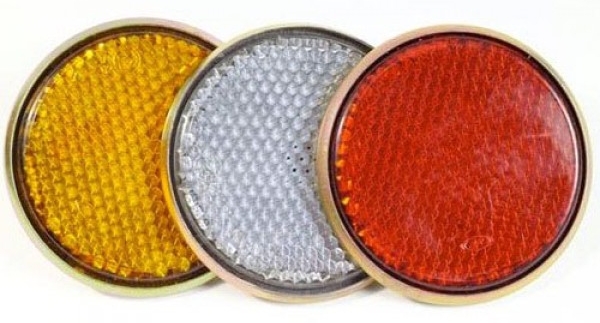
But those bike reflectors, which were a bargaining chip in most children's exchanges, it is worth recognizing, were an order of magnitude higher than the entire props, which are actively sold and are now sold in stalls and shops under the proud name of “flicker”. From a scientific point of view, the main criterion for assessing the quality of a retroreflective material is the coefficient of retroreflectivity (CS). This is an indicator of the intensity with which the ray of light reflected from the illuminated surface returns (= the ratio of the brightness of the surface of the sample to its illumination). The COP is expressed in candelas / lux / m 2 (English (cd / lux / m 2 ). Naturally, the higher the COP, the better the reflector carrier will be visible on the road. The picture below clearly confirms this thesis:
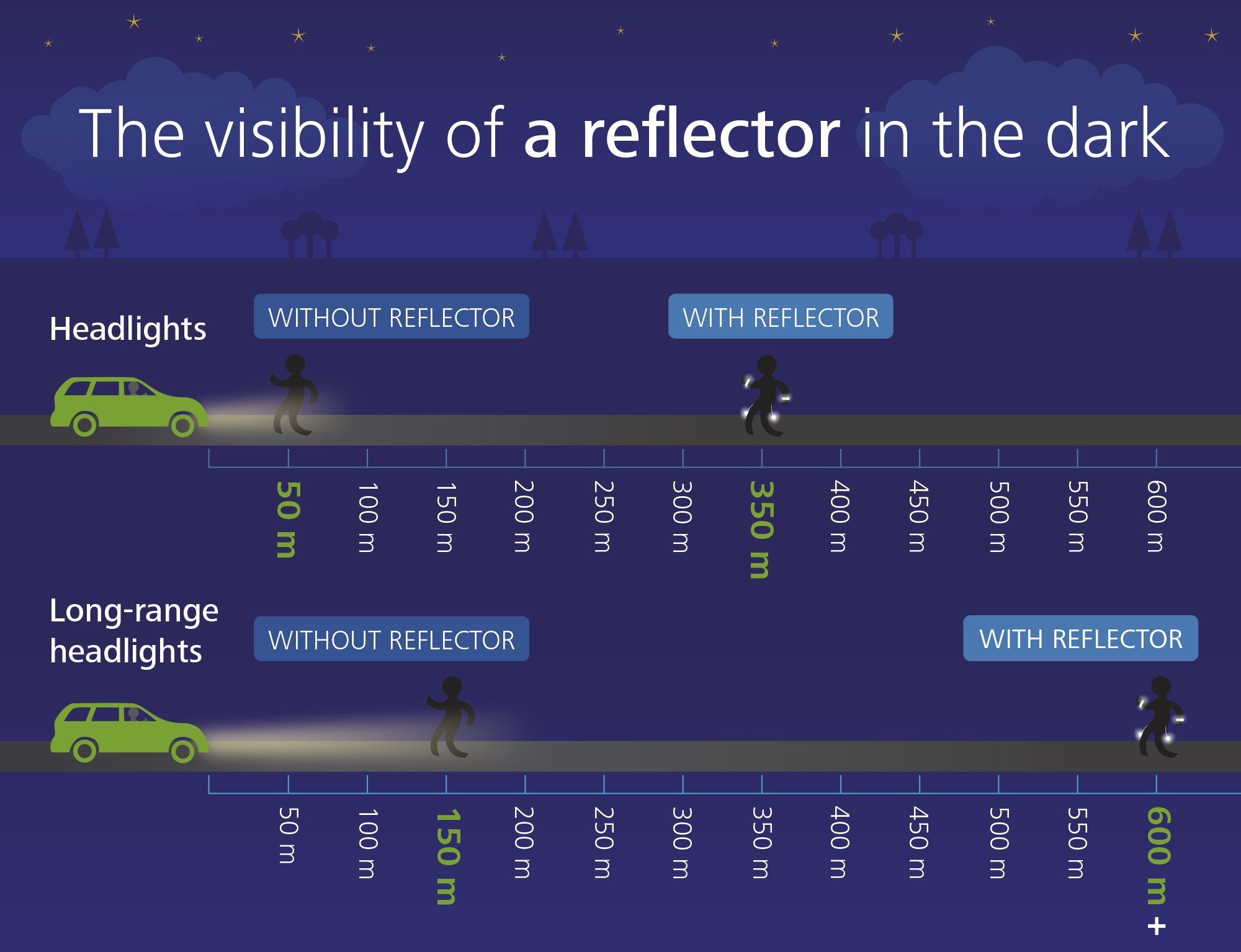
Well, and visibility? Visibility, in turn, is closely related to pedestrian safety and the braking distance of the car. All the best to the traffic police, therefore it is their retroreflective elements on vests that can act as a standard, their CS should be at least 550 cd / lux / m 2 . And I have no doubt that such numbers really have a place to be, the benefit of the representatives of this profession, as a rule, even have instruments for measuring reflectivity - retroreflectometers. In addition to traffic cops, such a toy can be in road builders, etc. professionals involved in reflective road marking / signs. The picture below shows such a device (with a considerable cost, by the way).
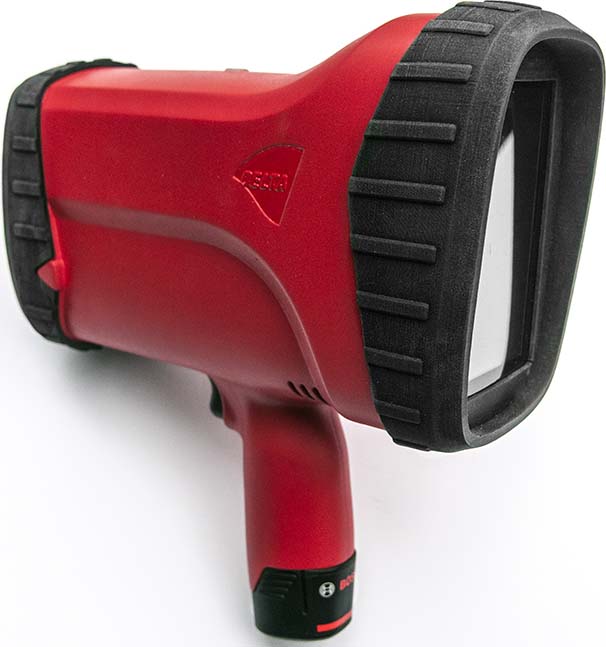
With it, you can definitely choose the best reflector. There is no access to the device - you will have to rely on luck and hope that the Chinese flicker has done everything in good faith. The most common retroreflective materials are either microspheres or microprisms. The retroreflectivity coefficient of microprismatic material is tens of times greater than that of microspheres, but the cost is correspondingly higher.
When choosing a flicker, you can additionally be guided by a couple more recommendations:
In general, the simplest way to test the health of flickers can be a “flash test”: a product made of retroreflective material can be photographed on a smartphone with a flash from a distance of 3-5 meters and see the result.

The correct retroreflector will glow in bright white (by the way, no matter what color the retroreflector is, the light reflected from it is always white), false - it will not glow, well, or it will do it with much lower intensity.
In addition to the likelihood of acquiring counterfeit initially, there is such a thing as the degradation of the retroreflective layer over time (= pollution / wear, etc.). Often this piece of retroreflective tape is hung somewhere and they forget about it ... The result is something like:
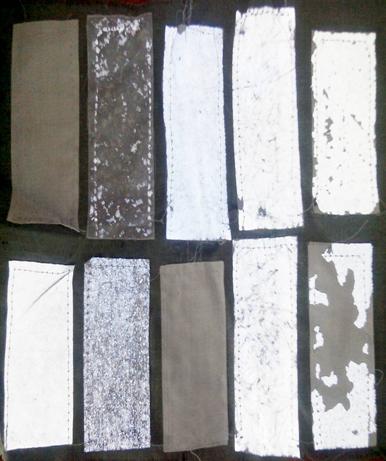
It’s possible that such a thing will be avoided, but life may not be able to be saved ... Besides hinged elements, this item applies very strongly to workwear with non-removable retroreflective elements, especially after washing with active detergents in harsh conditions.
The second serious drawback of flickers is their poor efficiency in adverse weather conditions: rain, snow, fog, in cloudy weather. Naturally, these conditions do not reduce the braking distance of the car either (see the picture, the values are miles per hour and feet of the braking distance, of course not very relevant for the countries of the winning metric system, but I did not want to redo the beautiful picture, I’ll add the decoding 1 mile = 1, 6 km, 1 ft = 0.3 m).
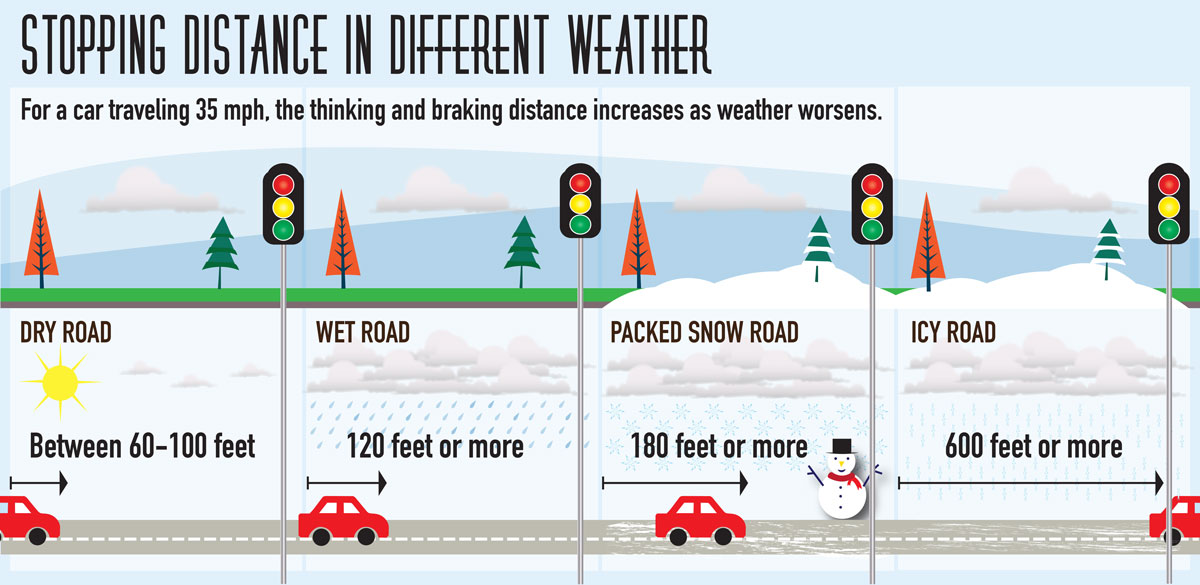
In severe weather conditions, the light from ordinary car headlights, or rather, the dipped and especially high beams, reflected and scattered from the smallest drops of water or snowflakes, creates a translucent veil that reduces visibility (for colloidal chemists, a reminder about the Tyndall cone ). When the main headlights are illuminated in the fog, a ray of light is scattered, partially reflected from drops, blinding the driver and significantly impairing visibility. This effect is most noticeable in the short-wave part of the spectrum corresponding to blue. Accordingly, when the road is illuminated by a lamp behind red or yellow filters, the reflection effect decreases, visibility becomes better. Actively exploit this opportunity fog lights. Fog, for example, tends to hang over the surface of paved roads at a certain distance. Therefore, the light of low mounted headlights is less affected by light reflection from water droplets - the headlights in this case shine “under the fog”, forming a sharply directed light stream at a height of about half a meter from the road surface and highlighting the curb. Rain and snowfall, by the way, do not possess such a property.
IMHO you need to do an active "flicker", i.e. to carry a flashlight-beacon (which I constantly recommend to people who are concerned about their road safety). Cyclists have a bunch of adapt, a taillight, finally. But what do pedestrians do?
As a result of reflection, the requirement for a lighthouse was formed:
1) Minimum size (and preferably a minimum number of parts)
2) Power supply from one 1.5 V battery (the most extreme option is a 3 V lithium tablet)
2a) Maximum energy efficiency (there is no Li-ion there and charging via microUSB)
3) Switchable mode (continuous light / fast blinking / slow blinking)
The first thing that came to mind was a blinking LED. In fact, this is a regular LED with a built-in integrated pulse generator with a flash frequency of 1.5 - 3 Hz. You can distinguish by the image in the datasheet - the arrows showing the light are dotted

The main disadvantage of such a beacon is that the frequency of flashes is unstable and varies depending on the supply voltage. Plus, to work with low power, you still have to do something like blocking a generator. Plus, there is no way to switch modes.
Next, we went to specialized driver chips for LED flashing lights. An example is LED Flasher IC 1Hz Flashing Driver M34
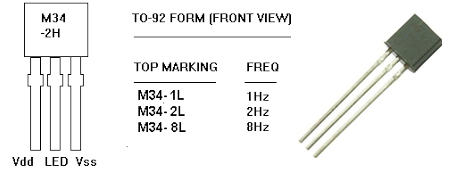
Here the problem is the same - the inability to control the mode (only a fixed switching frequency 1/2/8 Hz). Well, I still could not find these chips for a reasonable price. Apparently, the manufacturer didn’t do business.
The LM3909 flasher chip was also a rare, expensive and overall option.
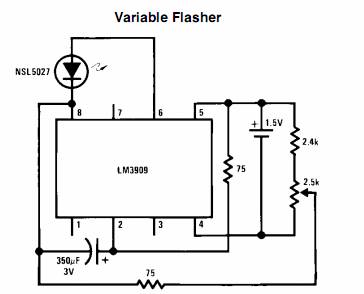
Although the thing is definitely worthy: here you have the ability to work from 1.5 V, and analog control of the blinking frequency. Release its manufacturer in some smd-case and I would be satisfied with this option. But no. As an option, I considered the "surrogates LM3909":
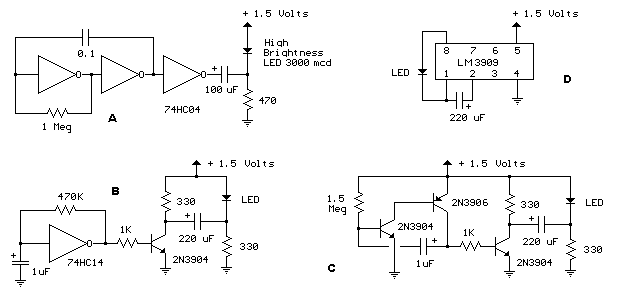
Both with the use of microcircuits (74NS04-A, 74HC14-B), and purely on transistors (option C), the device can work from 1.5 V, but it turns out even with smd-dimensions quite dimensional. Approximately the same as the flasher on the 555 timer (but in the case of a timer there are power restrictions).
Out of the competition (just because of the unusual performance), several more devices were considered. For example, a circuit using a relay:
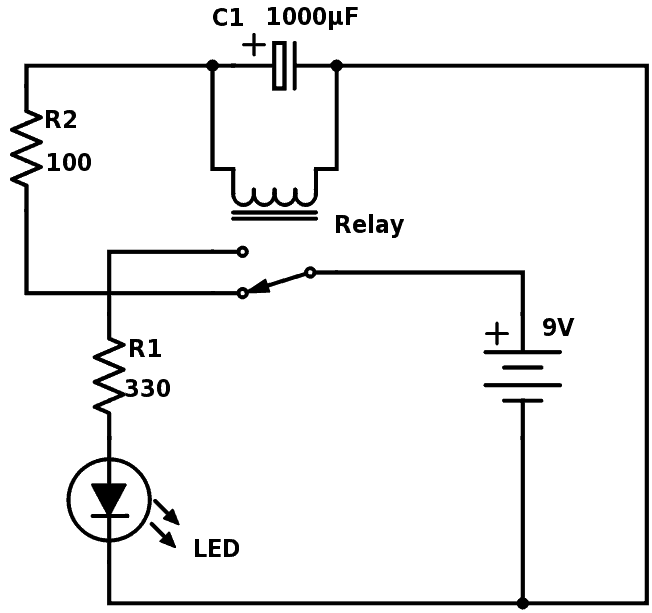
Neither in terms of miniaturization nor in terms of energy efficiency did such a thing suit me, but I love these “lamp clicks”. An interesting option (also quite energy-intensive, but unique in its power) is a flasher of a powerful LED and a special flashing neon lamp (it blinks due to bending of a bimetallic contact plate under heating).
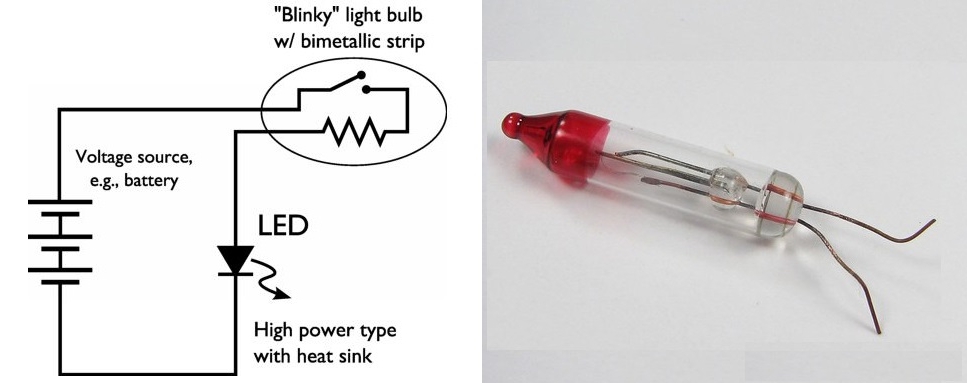
Despite the gluttony and size, the device flashes beautifully, like a small beacon ...
Another interesting option (interesting in the light of replacing the wire coils of the blocking generators, because it’s my winding up the coils that takes the last effort) can be the use of the driver chip 5252F (a popular thing for various designs based on solar panels). Everything would be fine (including the presence of the TO-94 case), but again there is no adjustment of the blinking frequency.
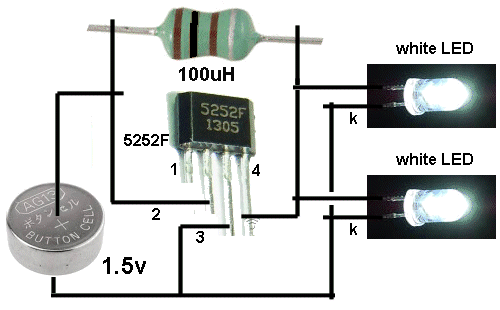
It would seem, no, no, and even the thought “is there really nothing?”. The most interesting thing is. And designed, I suspect, in China. This piece is called PET LED and is a device sealed in a ball of elastic plastic, powered by a 3V lithium battery.
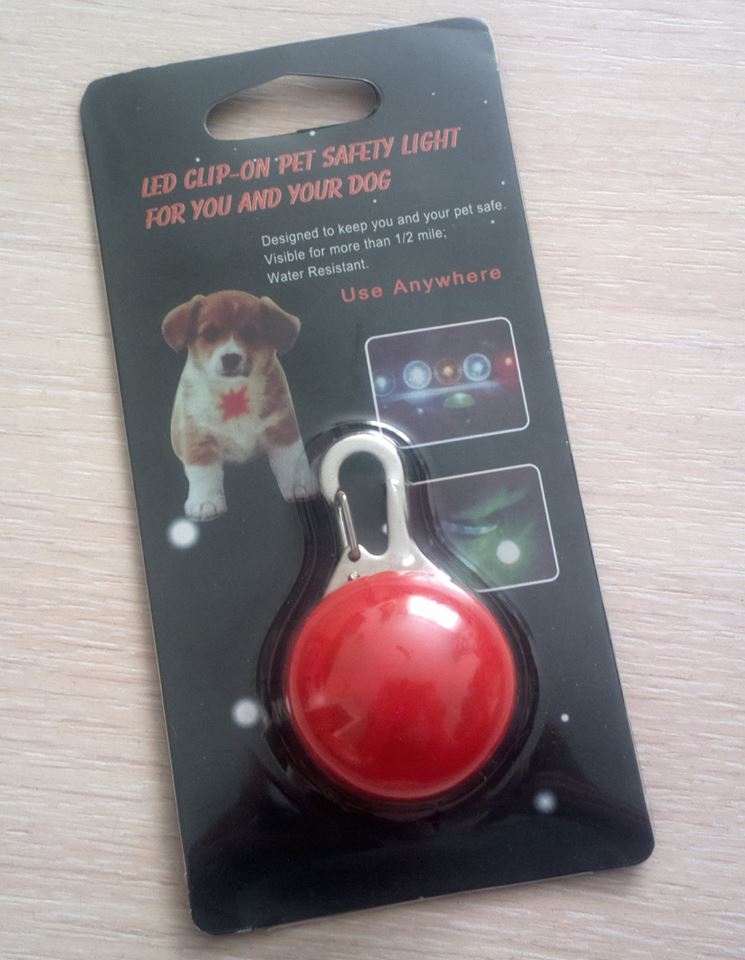
Inside there is an LED, a button, a battery and ... a drop of epoxy compound with a certain unpacked product.

There are options in a non-moisture resistant version, positioning themselves as a "flasher cyclist." Interestingly, on different types of power - 1x3v or 2x1.5 in

Inside, already traditionally - blah blah blah and a drop of compound:
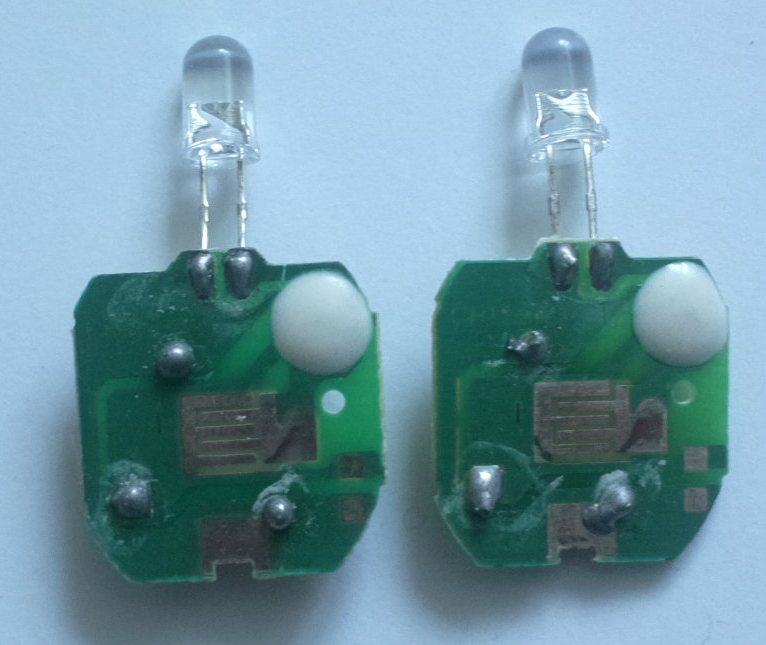
Most of those with whom I discussed this issue agree that the microcontroller is poured into the compound. The first thought was, traditionally, arduino. All kinds of lilypads, despite their simplicity and their wearable orientation, take up a lot of space and require conductors in the form of conductive threads. Of course, it’s not about cheapness. Well, LilyTiny on attiny85 also eats energy as if not in itself.

Digging on the Internet could not give me an answer to the question “what is there under the compound” and, in general, I came to the point of no return, for which I was only turning for advice to the collective wisdom of the habr community. Guys, electronics developers and hobbyists, maybe someone has thoughts on such an ultra-simple and ultra-economical beacon? And is it possible to implement such a tiny device on a microcontroller, which together with the LED (smd) would have enough voltage of 1.5 V. Available in our area atiny 13 or pic10, according to reviews, they don’t really want to work at low voltages, they crash and turn off the peripherals ...
UPDATE : an interesting option threw drWhy . This is a flasherfrom the spinner. I immediately liked this idea, because it meant exactly what I needed. But suddenly, trying to find a spinner (!) In Minsk, I came across a complete absence of such pieces. They disappeared in one fell swoop (moreover, some month ago, spinner-madness was observed everywhere, from underpasses to airports). The only suitable model for disassembly was caught in Gorky Park. Suitable = one in which the microcircuit would not be embedded in the compound (I had to open the case and check so as not to take the next cat in the bag). As a result, such a thing was found, three miniature flashlights in sealed cases - for only $ 1.5. You can take and use. So far, this is the absolute leader in terms of price (even without taking into account the fact that you can get three (!) Spinners with three beacons in each for $ 1.5;

Inside, there were three LEDs of different colors, a button, a microcontroller (?) Or some tricky LED driver + two LR1130 batteries. An approximate schematic looks something like this:

It’s true to establish what kind of thing is “TX-333” (and find the datasheet) so far I have not succeeded ... It really reminds attiny10 of some kind or pic10, but I can not confirm :)


This whole story began with the fact that in early 2007 the GAI of Belarus announced the implementation of the Minus 100 campaign, whose goal was to "reduce the number of deaths from road traffic crashes by at least 100 people compared to 2006." At the same time, personal mounted retroreflective elements - “flickers” were massively thrown into the sale. The state media acted as informational support, urging their propaganda materials to stimulate unprecedented demand for these crafts. The progressive part of the population took this, generally good idea, with hostility, the fact of the presence of a flicker automatically equated the wearer with the lowest layers of the population. Perhaps this is due to the fact that initially these "state retroreflectors" were from the same sphere, as fire detectors / validators in public transport, etc. + disgusting, artsy design / drawing and all that’s all (after 5-7 years, by the way, neutral models or just _ne_ cutting eyes) began to appear). The second factor was the fact that despite the fact that the flicker was required to be worn only on dark, unlit sections of the road, in the traffic police provinces they caught and fined people without flickers even in an open field (I exaggerate, but not much). It is worth noting that the flickers still did their good deed. in the provinces of the traffic police caught and fined people without flickers even in the open field (I exaggerate, but not much). It is worth noting that the flickers still did their good deed. in the provinces of the traffic police caught and fined people without flickers even in the open field (I exaggerate, but not much). It is worth noting that the flickers still did their good deed.
Emotion is good and facts are better
Despite the negative attitude to the flicker-madness initiated by the traffic police, I have a very positive attitude to the phenomenon of retroreflection. Even if only because I had known this concept since childhood, when the number of “reflectors” on a bicycle was an indicator of the “status” of its owner. For those who still forgot what it is, I recall the excerpt from RU Wikipedia:
Reflector (dr. Greek κατα- “prefix with a counteraction value” + φῶς “light”), retroreflector, retroreflector, flicker (from the English flicker) - a device designed to reflect the light beam towards the source with minimal diffusion. Retroreflection is the process of changing the direction of the beam by 180 ° using double reflection. When retroreflective, in contrast to light reflection, the beam is reflected twice.

But those bike reflectors, which were a bargaining chip in most children's exchanges, it is worth recognizing, were an order of magnitude higher than the entire props, which are actively sold and are now sold in stalls and shops under the proud name of “flicker”. From a scientific point of view, the main criterion for assessing the quality of a retroreflective material is the coefficient of retroreflectivity (CS). This is an indicator of the intensity with which the ray of light reflected from the illuminated surface returns (= the ratio of the brightness of the surface of the sample to its illumination). The COP is expressed in candelas / lux / m 2 (English (cd / lux / m 2 ). Naturally, the higher the COP, the better the reflector carrier will be visible on the road. The picture below clearly confirms this thesis:

Clothing color also affects visibility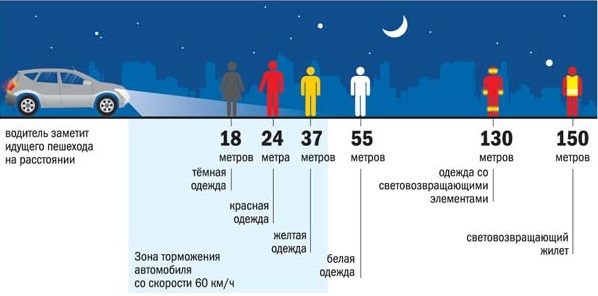

Well, and visibility? Visibility, in turn, is closely related to pedestrian safety and the braking distance of the car. All the best to the traffic police, therefore it is their retroreflective elements on vests that can act as a standard, their CS should be at least 550 cd / lux / m 2 . And I have no doubt that such numbers really have a place to be, the benefit of the representatives of this profession, as a rule, even have instruments for measuring reflectivity - retroreflectometers. In addition to traffic cops, such a toy can be in road builders, etc. professionals involved in reflective road marking / signs. The picture below shows such a device (with a considerable cost, by the way).

With it, you can definitely choose the best reflector. There is no access to the device - you will have to rely on luck and hope that the Chinese flicker has done everything in good faith. The most common retroreflective materials are either microspheres or microprisms. The retroreflectivity coefficient of microprismatic material is tens of times greater than that of microspheres, but the cost is correspondingly higher.
When choosing a flicker, you can additionally be guided by a couple more recommendations:
- products with a white or lemon color (for PVC substrates) and gray textile tapes usually have the best retroreflectivity
- corrugated products are more effective than flat ones because of the ability to work better with wide angles of light incidence
- images / logos / labels in large quantities on a retroreflective surface seriously reduce retroreflectivity
- when using retroreflectors in the form of hinged trinkets, the application of a functional coating only on the front side
- ceteris paribus, the best retroreflective characteristics have options made using a yellow microprismatic film with combined properties - retroreflection and fluorescence. Retroreflection provides the visibility of the optical element at night, and fluorescence makes the optical element brighter in conditions of poor visibility.
In general, the simplest way to test the health of flickers can be a “flash test”: a product made of retroreflective material can be photographed on a smartphone with a flash from a distance of 3-5 meters and see the result.

The correct retroreflector will glow in bright white (by the way, no matter what color the retroreflector is, the light reflected from it is always white), false - it will not glow, well, or it will do it with much lower intensity.
In addition to the likelihood of acquiring counterfeit initially, there is such a thing as the degradation of the retroreflective layer over time (= pollution / wear, etc.). Often this piece of retroreflective tape is hung somewhere and they forget about it ... The result is something like:

It’s possible that such a thing will be avoided, but life may not be able to be saved ... Besides hinged elements, this item applies very strongly to workwear with non-removable retroreflective elements, especially after washing with active detergents in harsh conditions.
The second serious drawback of flickers is their poor efficiency in adverse weather conditions: rain, snow, fog, in cloudy weather. Naturally, these conditions do not reduce the braking distance of the car either (see the picture, the values are miles per hour and feet of the braking distance, of course not very relevant for the countries of the winning metric system, but I did not want to redo the beautiful picture, I’ll add the decoding 1 mile = 1, 6 km, 1 ft = 0.3 m).

In severe weather conditions, the light from ordinary car headlights, or rather, the dipped and especially high beams, reflected and scattered from the smallest drops of water or snowflakes, creates a translucent veil that reduces visibility (for colloidal chemists, a reminder about the Tyndall cone ). When the main headlights are illuminated in the fog, a ray of light is scattered, partially reflected from drops, blinding the driver and significantly impairing visibility. This effect is most noticeable in the short-wave part of the spectrum corresponding to blue. Accordingly, when the road is illuminated by a lamp behind red or yellow filters, the reflection effect decreases, visibility becomes better. Actively exploit this opportunity fog lights. Fog, for example, tends to hang over the surface of paved roads at a certain distance. Therefore, the light of low mounted headlights is less affected by light reflection from water droplets - the headlights in this case shine “under the fog”, forming a sharply directed light stream at a height of about half a meter from the road surface and highlighting the curb. Rain and snowfall, by the way, do not possess such a property.
What to do in such a situation?
IMHO you need to do an active "flicker", i.e. to carry a flashlight-beacon (which I constantly recommend to people who are concerned about their road safety). Cyclists have a bunch of adapt, a taillight, finally. But what do pedestrians do?
As a result of reflection, the requirement for a lighthouse was formed:
1) Minimum size (and preferably a minimum number of parts)
2) Power supply from one 1.5 V battery (the most extreme option is a 3 V lithium tablet)
2a) Maximum energy efficiency (there is no Li-ion there and charging via microUSB)
3) Switchable mode (continuous light / fast blinking / slow blinking)
The first thing that came to mind was a blinking LED. In fact, this is a regular LED with a built-in integrated pulse generator with a flash frequency of 1.5 - 3 Hz. You can distinguish by the image in the datasheet - the arrows showing the light are dotted

The main disadvantage of such a beacon is that the frequency of flashes is unstable and varies depending on the supply voltage. Plus, to work with low power, you still have to do something like blocking a generator. Plus, there is no way to switch modes.
Next, we went to specialized driver chips for LED flashing lights. An example is LED Flasher IC 1Hz Flashing Driver M34

Here the problem is the same - the inability to control the mode (only a fixed switching frequency 1/2/8 Hz). Well, I still could not find these chips for a reasonable price. Apparently, the manufacturer didn’t do business.
The LM3909 flasher chip was also a rare, expensive and overall option.

Although the thing is definitely worthy: here you have the ability to work from 1.5 V, and analog control of the blinking frequency. Release its manufacturer in some smd-case and I would be satisfied with this option. But no. As an option, I considered the "surrogates LM3909":

Both with the use of microcircuits (74NS04-A, 74HC14-B), and purely on transistors (option C), the device can work from 1.5 V, but it turns out even with smd-dimensions quite dimensional. Approximately the same as the flasher on the 555 timer (but in the case of a timer there are power restrictions).
Out of the competition (just because of the unusual performance), several more devices were considered. For example, a circuit using a relay:

Neither in terms of miniaturization nor in terms of energy efficiency did such a thing suit me, but I love these “lamp clicks”. An interesting option (also quite energy-intensive, but unique in its power) is a flasher of a powerful LED and a special flashing neon lamp (it blinks due to bending of a bimetallic contact plate under heating).

Despite the gluttony and size, the device flashes beautifully, like a small beacon ...
Another interesting option (interesting in the light of replacing the wire coils of the blocking generators, because it’s my winding up the coils that takes the last effort) can be the use of the driver chip 5252F (a popular thing for various designs based on solar panels). Everything would be fine (including the presence of the TO-94 case), but again there is no adjustment of the blinking frequency.

It would seem, no, no, and even the thought “is there really nothing?”. The most interesting thing is. And designed, I suspect, in China. This piece is called PET LED and is a device sealed in a ball of elastic plastic, powered by a 3V lithium battery.

What is it







Inside there is an LED, a button, a battery and ... a drop of epoxy compound with a certain unpacked product.

There are options in a non-moisture resistant version, positioning themselves as a "flasher cyclist." Interestingly, on different types of power - 1x3v or 2x1.5 in

Inside, already traditionally - blah blah blah and a drop of compound:

Most of those with whom I discussed this issue agree that the microcontroller is poured into the compound. The first thought was, traditionally, arduino. All kinds of lilypads, despite their simplicity and their wearable orientation, take up a lot of space and require conductors in the form of conductive threads. Of course, it’s not about cheapness. Well, LilyTiny on attiny85 also eats energy as if not in itself.

And you still need to additionally
Battery compartment
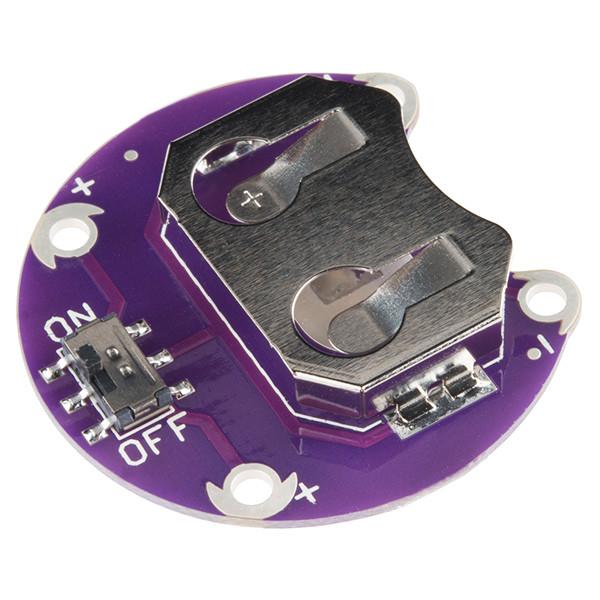
LED what LilyPad Pixel Board
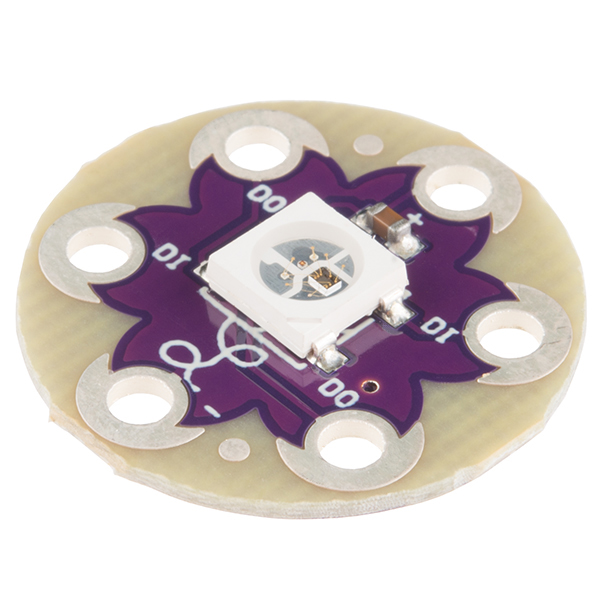
And wires
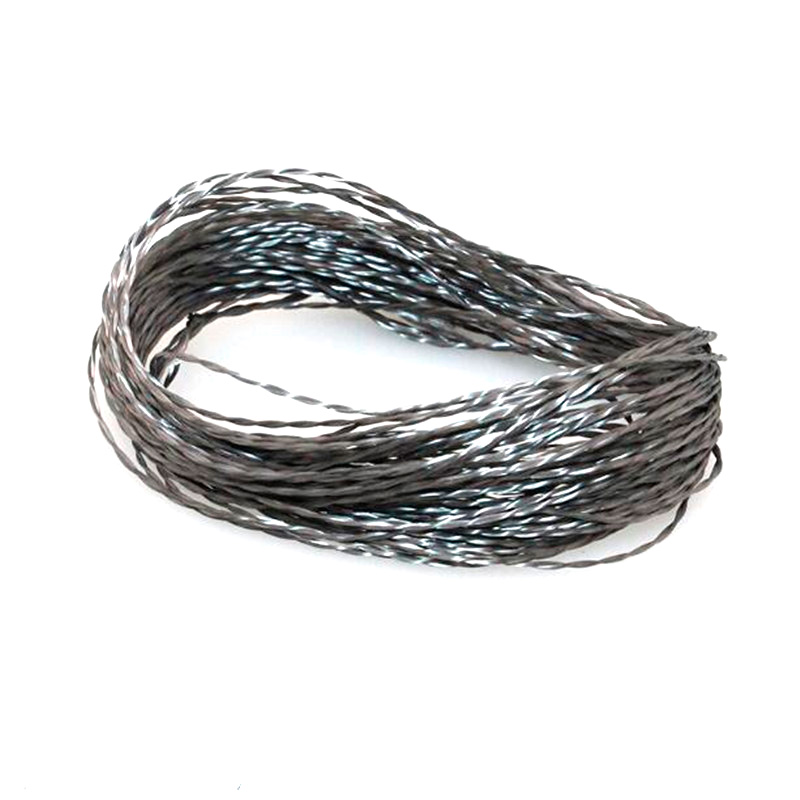

LED what LilyPad Pixel Board

And wires

Digging on the Internet could not give me an answer to the question “what is there under the compound” and, in general, I came to the point of no return, for which I was only turning for advice to the collective wisdom of the habr community. Guys, electronics developers and hobbyists, maybe someone has thoughts on such an ultra-simple and ultra-economical beacon? And is it possible to implement such a tiny device on a microcontroller, which together with the LED (smd) would have enough voltage of 1.5 V. Available in our area atiny 13 or pic10, according to reviews, they don’t really want to work at low voltages, they crash and turn off the peripherals ...
UPDATE : an interesting option threw drWhy . This is a flasherfrom the spinner. I immediately liked this idea, because it meant exactly what I needed. But suddenly, trying to find a spinner (!) In Minsk, I came across a complete absence of such pieces. They disappeared in one fell swoop (moreover, some month ago, spinner-madness was observed everywhere, from underpasses to airports). The only suitable model for disassembly was caught in Gorky Park. Suitable = one in which the microcircuit would not be embedded in the compound (I had to open the case and check so as not to take the next cat in the bag). As a result, such a thing was found, three miniature flashlights in sealed cases - for only $ 1.5. You can take and use. So far, this is the absolute leader in terms of price (even without taking into account the fact that you can get three (!) Spinners with three beacons in each for $ 1.5;

Photo in bulk

Inside, there were three LEDs of different colors, a button, a microcontroller (?) Or some tricky LED driver + two LR1130 batteries. An approximate schematic looks something like this:

It’s true to establish what kind of thing is “TX-333” (and find the datasheet) so far I have not succeeded ... It really reminds attiny10 of some kind or pic10, but I can not confirm :)


